How Paul Robeson Found His Political Voice in the Welsh Valleys
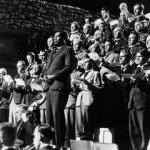
Paul Robeson possessed one of the most beautiful voices of the 20th century. He was an acclaimed stage actor. He could sing in more than 20 different languages; he held a law degree; he won prizes for oratory. He was widely acknowledged as the greatest American footballer of his generation. But he was also a political activist, who, in the 1930s and 1940s, exerted an influence comparable to Martin Luther King and Malcolm X in a later era.
Paul Robeson possessed one of the most beautiful voices of the 20th century. He was an acclaimed stage actor. He could sing in more than 20 different languages; he held a law degree; he won prizes for oratory. He was widely acknowledged as the greatest American footballer of his generation. But he was also a political activist, who, in the 1930s and 1940s, exerted an influence comparable to Martin Luther King and Malcolm X in a later era.
The son of an escaped slave, Robeson built his career despite the segregation of the Jim Crow laws – basically, an American apartheid system that controlled every aspect of African American life. He came to London with his wife Eslanda – known as Essie – partly to escape the crushing racism of his homeland. Yet later in life he always insisted that he became a radical as much because of his experiences in Britain as in America. In particular, he developed a deep bond with the labour movement – particularly with the miners of Wales. That was why, in 2016, I travelled from my home in Australia to visit the landscape that shaped Robeson’s politics.
Pontypridd was a village carved out of stone. Grey terraced cottages, grey cobbled streets, and an ancient grey bridge arching across the River Taff.
The sky was slate, too, a stark contrast with the surrounding hills, which were streaked with seasonal russet, teal and laurel.
I was accustomed to towns that sprawled, as white settlers stretched themselves out to occupy a newly colonised land. Pontypridd, I realised, huddled. Its pubs and churches and old-fashioned stores were clutched tightly in the valley, in a cosy snugness that left me feeling a long way from home. I’d come here to see Beverley Humphreys, a singer and the host of Beverley’s World of Music on BBC Wales.
“I have a strong feeling that we might meet in October!” she’d written, when I’d emailed her about the Paul Robeson exhibition she was organising. “I know from personal experience that once you start delving into Paul Robeson’s life, he just won’t leave you alone.”
In that correspondence, she’d described Pontypridd as the ideal place to grasp Paul’s rich relationship with Wales and its people. I knew that, in the winter of 1929, Paul had been returning from a matinee performance of Show Boat [in London] when he heard male voices wafting from the street. He stopped, startled by the perfect harmonisation and then by the realisation that the singers, when they came into view, were working men, carrying protest banners as they sang.
By accident, he’d encountered a party of Welsh miners from the Rhondda valley. They were stragglers from the great working-class army routed during what the poet Idris Davies called the “summer of soups and speeches” – the general strike of 1926. Blacklisted by their employers after the unions’ defeat, they had walked all the way to London searching for ways to feed their families. By then, Robeson’s stardom and wealth were sufficient to insulate him from the immiseration facing many British workers, as the industrialised world sank into the economic downturn known as the Great Depression.
Yet he remembered his father’s dependence on charity, and he was temperamentally sympathetic to the underdog. Without hesitation, he joined the march.
Some 50 years later, [his son] Pauli Robeson visited the Talygarn Miners’ Rehabilitation Centre and met an elderly man who’d been present on that day in 1929. The old miner talked of how stunned the marchers had been when Robeson attached himself to their procession: a huge African American stranger in formal attire incongruous next to the half-starved Welshmen in their rough-hewn clothes and mining boots.
But Robeson had a talent for friendship, and the men were grateful for his support. He had remained with the protest until they stopped outside a city building, and then he leaped on to the stone steps to sing Ol’ Man River and a selection of spirituals chosen to entertain his new comrades but also because sorrow songs, with their blend of pain and hope, expressed emotions that he thought desperate men far from home might be feeling.
Afterwards, he gave a donation so the miners could ride the train back to Wales, in a carriage crammed with clothing and food.
That was how it began. Before the year was out, he’d contributed the proceeds of a concert to the Welsh miners’ relief fund; on his subsequent tour, he sang for the men and their families in Cardiff, Neath, and Aberdare, and visited the Talygarn miners’ rest home in Pontyclun.
From then on, his ties with Wales only grew.
Robeson remained in Buckingham Street, London. He and Essie maintained a public profile as a celebrity couple, still mixing easily with polite society and the intelligentsia. But Robeson was now aware of the labour movement, and began to pay attention to its victories and defeats. His frequent visits to mining towns in Wales were part of that newfound political orientation.
“You can see why he’s remembered around here,” Humphreys said. “He was so famous when he made those connections, and the Welsh mining community was so very cowed. In the wake of the general strike, people felt pretty hopeless.”
A Robeson exhibition opened in Pontypridd in October 2015 and was an echo of a much grander presentation from 2001, which Humphreys had assembled with Hywel Francis, then Labour MP for Aberavon, and Paul Robeson Jr [Robeson’s son died in 2014]. It was first shown at the National Museum in Cardiff and then toured the country.
Staging that event had been a revelation for Humphreys. She’d known that memories of Robeson ran deep in Wales, but she’d still been astonished by the response. Every day of the exhibit, people shared their recollections, speaking with a hushed fervour about encounters with Paul that had stayed with them for ever.
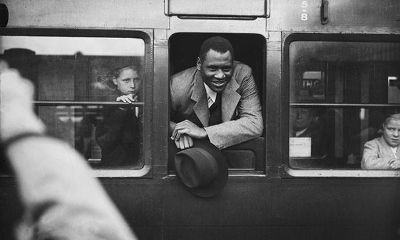
Paul’s interactions with Wales were shaped by the violence of mining life: the everyday hardship of long hours and low wages, but also the sudden spectacular catastrophes that decimated communities. In 1934, he’d been performing in Caernarfon when news arrived of a disaster in the Gresford colliery. The mine there had caught fire, creating an inferno so intense that most of the 266 men who died underground, in darkness and smoke, were never brought to the surface for burial. At once, Robeson offered his fees for the Caernarfon concert to the fund established for the orphans and children of the dead – an important donation materially, but far more meaningful as a moral and political gesture.
That was part, Humphreys said, of why Wales remembered him. He was by then among the most famous stars of the day, the recording artist whose songs many hummed, and yet he was showing an impoverished and struggling community – people who felt themselves isolated and abandoned — that he cared deeply about them.
And the continuing affection for Robeson was more than a recollection of generosity. “The Welsh sensed the relationship was reciprocal, said Humphreys. “That he was deriving something from their friendships, from seeing how people in the mining communities supported one another and cared for one another. He later said he learned more from the white working class in Wales than from anyone.”.
Certainly, Robeson discovered Wales – and the British working class in general – at just the right time. He’d signed up, with great hopes, for a film version of [Eugene O’Neill’s play] The Emperor Jones in 1933 – the first commercial film with a black man in the lead. But the process played out according to a familiar and dispiriting pattern. Robeson’s contract stipulated that, during his return to America, he wouldn’t be asked to film in Jim Crow states. Star or not, it was impossible to be shielded from institutional racism. At the end of his stay, as he arrived at a swanky New York function, he was directed to the servants’ entrance rather than the elevator. One witness said he had to be dissuaded from punching out the doorman, in a manifestation of anger he’d never have revealed in the past.
The Emperor Jones itself was still very much shaped by conservative sensibilities: among other humiliations, the studio darkened the skin of his co-star, lest audiences thought Robeson was kissing a white woman. Not surprisingly, while white critics loved the film and Robeson’s performance, he was again attacked in the African American press for presenting a demeaning stereotype.
A few years earlier, he might have found refuge in London from the impossible dilemmas confronting a black artist in America. But he’d learned to see respectable England as disconcertingly similar, albeit with its prejudices expressed through nicely graduated hierarchies of social class. To friends, he spoke of his dismay at how the British upper orders related to those below them. He was ready, both intellectually and emotionally, for the encounter with the Welsh labour movement.
“There was just something,” Humphreys said, “that drew Welsh people and Paul Robeson together. I think it was like a love affair, in a way.” And that seemed entirely right.
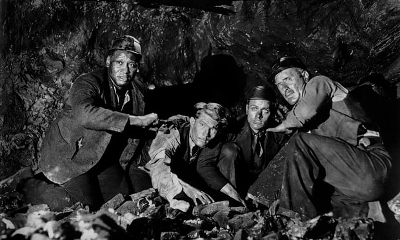
The next morning, Humphreys and I walked down the hill, beneath a sky that warned constantly of rain. We made our way to St David’s Uniting Church on Gelliwastad Road. From the outside, it seemed like a typically stern embodiment of Victorian religiosity: a grey, rather grim legacy of the 1880s.
Inside, though, the traditional church interior – the pews, the pulpit, the altar – was supplemented by a huge banner from the Abercrave lodge of the National Union of Mineworkers, hanging just below the stained-glass windows. Workers of the world unite for peace and socialism, it proclaimed, with an image of a black miner holding a lamp out to his white comrade in front of a globe of the world.
The walls held huge photos of Paul Robeson: in his football helmet on the field at Rutgers ; on a concert stage, his mouth open in song; marching on a picket line. These were the displays extracted from the 2001 exhibition.
We chatted with parishioners, who were taking turns to keep the Robeson display open during the day for black history month.
The service itself reminded me of my morning in the Witherspoon Street church, except that, while in Princeton [where Robeson was born] I’d marvelled at the worshippers’ command of the black vocal tradition, here I was confronted by the harmonic power of Welsh choristers: the old hymns voiced in a great wall of sound resonating and reverberating throughout the interior.
Robeson, of course, had made that comparison many times. Both the Wesleyan chapels of the Welsh miners and the churches in which he’d worshipped with his father were, he said, places where a weary and oppressed people drew succour from prayer and song.
His movie The Proud Valley (released as The Tunnel in the US), which had brought him to Pontypridd in 1939, rested on precisely that conceit. In the film (the only one of his movies in which he took much pride), Robeson played David Goliath, an unemployed seaman who wanders into the Welsh valley and is embraced by the miners when the choir leader hears him sing.
Throughout the 1930s, the analogy between African Americans and workers in Britain (and especially Wales) helped reorient Robeson, both aesthetically and politically, after his disillusionment with the English establishment.
His contact with working-class communities in Britain provided him with an important reassurance. He told his friend Marie Seton about a letter he received from a cotton-spinner during one of his tours. “This man said he understood my singing, for while my father was working as a slave, his own father was working as a wage slave in the mills of Manchester.”
That was in northern England, but he experienced a similar commonality everywhere, and it pleased and intrigued him. If the slave songs of the US were worth celebrating, what about the music emerging from other oppressed communities? What connections might the exploration of distinctive cultural traditions forge between different peoples?
Significantly, it was in Wales where Robeson first articulated this new perspective. In 1934, he gave a concert in Wrexham, in north Wales, between the Welsh mountains and the lower Dee valley alongside the border with England. Yet again it was a charity performance, staged at the Majestic Cinema for the benefit of the St John Ambulance Association.
During the visit, Robeson was interviewed by the local paper, and he told the writer he was no longer wedded to a classical repertoire. He’d come to regard himself as a folk singer, devoted to what he called “the eternal music of common humanity”. To that end, he was studying languages, working his way haphazardly through Russian, German, French, Dutch, Hungarian, Turkish, Hebrew, and sundry other tongues so as to perform the songs of different cultures in the tongues in which they had been written. He had become, he said, a singer for the people.
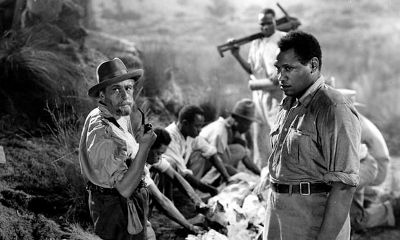
The confidence of that statement reflected another lesson drawn primarily from Wales. In African American life, the black church had mattered so much because religion provided almost the only institutional stability for people buffeted by racial oppression. In particular, because Jim Crow segregated the workplace, black communities struggled to form and maintain trade unions. Wales, though, was different. The miners found consolation in religion, with every village dotted with chapels. But they believed just as fervently in trade unionism.
The Gresford disaster showed why. In an industry such as mining, you relied on your workmates – both to get the job done safely and to stand up for your rights. The battle was necessarily collective. A single miner possessed no power at all; the miners as a whole, however, could shut down the entire nation, as they’d demonstrated in 1926.
In particular, the cooperation mandated by modern industry might, at least in theory, break down the prejudices that divided workers – even, perhaps, the stigma attached to race. That was the point Robeson dramatised in The Proud Valley, a film in which the solidarity of the workplace overcomes the miners’ suspicion about a dark-skinned stranger. “Aren’t we all black down that pit?” asks one of the men.
“It’s from the miners in Wales,” Robeson explained, “ I first understood the struggle of Negro and white together.”
“To understand Paul’s relationship with Wales,” Humphreys told me the following day, “you need to understand Tiger Bay.”
She introduced me to Lesley Clarke and to Harry Ernest and his son Ian. The three of them came from Tiger Bay, the centre of Wales’s black community. They’d worked on the original exhibition in Cardiff, after Humphreys had insisted that the National Gallery employ black guides, and now they’d come to Pontypridd to witness the new display.
At 82, Lesley Clarke was thin but sprightly and alert. She spoke slowly and carefully. “I hadn’t realised there was a colour bar until I left Tiger Bay. When I went to grammar school, I realised for the first time that there were people who just didn’t like coloured people. Didn’t know anything about us, but didn’t like us. I didn’t know I was poor and I didn’t know I was black: all I knew was that I was me.”
Tiger Bay was forged by some of the worst racial attacks in British history. In June 1919, returning soldiers encountered a group of black men walking with white women. Outraged, the troops, led by colonials (mostly Australians), rampaged throughout Butetown, attacking people of colour, destroying houses, and leaving four dead.
For Clarke and Ernest’s generation, the colour bar was very real, especially in employment. Ernest was impish and bald, and his eyes crinkled as he spoke, almost as if he took a perverse humour in the recollection. “We’d ask if a job was open,” he said, “and soon as they said yes, we’d say, ‘Can I come for an interview right now?’ To narrow the gap, because the minute you got there they would say, ‘Oh, the job is gone.’”
“The minute they saw you were black, that was it,” said Clarke. “You just took it for granted that it was going to happen. There were very few outlets, especially for girls. You either worked in the brush factory or you worked in Ziggy’s, selling rags and whatnot, or there was a place just over the bridge that did uniforms.”
“I worked in the brush factory for a while,” Ernest said. “Oh, Jesus!”
He shook his head and laughed in dismay. “Jesus.”
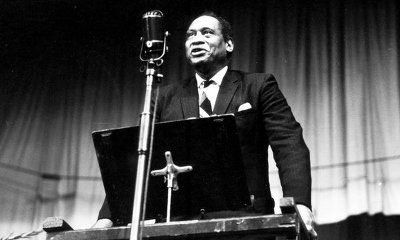
Robeson had reached out to the Welsh miners when his career was at its height. They came back to him at his lowest ebb, almost two decades later, at a time when all he’d achieved seemed to have been taken from him. In the midst of the cold war, the FBI prevented Robeson from performing at home. [He’d proclaimed his sympathy for the Soviet Union ever since the mid-30s. That leftism now made him a target. He became, in Pete Seeger’s words, “the most blacklisted performer in America”, effectively silenced in his home country,] Worse still, the US state department confiscated his passport, so he could not travel abroad. He was left in a kind of limbo: silenced, isolated, and increasingly despairing.
On 5 October 1957, the Porthcawl Grand Pavilion filled with perhaps 5,000 people for the miners’ eisteddfod. Will Painter, the union leader, took to the microphone. After welcoming the delegates, he announced that they would soon hear from Paul Robeson, who’d be joining them via a transatlantic telephone line.
When Painter spoke again, he was addressing Robeson directly. “We are happy that it has been possible for us to arrange that you speak and sing to us today,” he said. “We would be far happier if you were with us in person.”
Miraculously, Robeson’s deep voice crackled out of the speakers in response. “My warmest greetings to the people of my beloved Wales, and a special hello to the miners of south Wales at your great festival. It is a privilege to be participating in this historic festival.”
He was seated in a studio in New York. Down the telephone line, he performed a selection of his songs, dedicating them to their joint struggle for what he called “a world where we can live abundant and dignified lives”.
The musical reply came from the mighty Treorchy Male Choir, the winners of that year’s eisteddfod, and a group that traces its history back to 1883. Robeson joined the choir in a performance of the Welsh national anthem, Land of My Fathers, before the entire audience – all 5,000 of them – serenaded him with We’ll Keep a Welcome. “This land you knew will still be singing,” they chorused. “When you come home again to Wales.”
